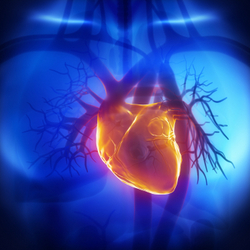
After a heart attack, much of the damage to the heart muscle is caused by inflammatory cells that rush to the scene of the oxygen-starved tissue. But that inflammatory damage is slashed in half when microparticles are injected into the blood stream within 24 hours of the attack, according to new preclinical research from Northwestern Medicine and the University of Sydney in Australia.
When biodegradable microparticles were injected after a heart attack, the size of the heart lesion was reduced by 50 percent and the heart could pump significantly more blood.
“This is the first therapy that specifically targets a key driver of the damage that occurs after a heart attack,” said investigator Daniel Getts, a visiting scholar in Microbiology-Immunology at Northwestern University Feinberg School of Medicine. “There is no other therapy on the horizon that can do this. It has the potential to transform the way heart attacks and cardiovascular disease are treated.”
The micoparticles work by binding to the damaging cells – inflammatory monocytes – and diverting them to a fatal detour. Instead of racing to the heart, the cells head to the spleen and die.
The particles are made of poly (lactic-co-glycolic) acid, a biocompatible and biodegradable substance already approved by the Food and Drug Administration for use in re-absorbable sutures. A microparticle is 500 nanometers, which is 1/200th the size of a hair.
The scientists’ study showed that the microparticles reduced damage and repaired tissue in many other inflammatory diseases. These include models of West Nile virus, colitis, inflammatory bowel disease, multiple sclerosis, peritonitis and a model that mimics blood flow after a kidney transplant.
“The potential for treating many different diseases is tremendous,” said investigator Stephen Miller, PhD, the Judy Gugenheim Research Professor at Feinberg. “In all these disease models, the microparticles stop the flood of inflammatory cells at the site of the tissue damage, so the damage is greatly limited and tissues can regenerate.”
Getts, Miller and Nicholas King, professor of Viral Immunopathology at the University of Sydney School of Medical Sciences, are corresponding authors on the paper, which was published January 15 in Science Translational Medicine.
Biotech Startup Aims for FDA Approval and Clinical Trial
The Northwestern and University of Sydney results are so encouraging, the scientists have partnered with a startup biotechnology company, Cour Pharmaceutical Development Co., to produce a refined version of the microparticles in anticipation of what they hope will be a clinical trial in myocardial infarction (heart attack) within two years. The company plans to submit an investigational new drug application to the FDA.
“This discovery has the potential to transform how inflammatory disorders are treated and the use of microparticles derived from biodegradable polymers means that this therapy could be rapidly translated for clinical use,” said John Puisis, the chief executive officer of Cour.
How a Fatal Attraction Saves the Heart
The microparticles are designed to have a negative charge on their surface. This makes them irresistible to the inflammatory monocytes, which have a positively charged receptor. It’s a fatal attraction. When the inflammatory cell bonds to the microparticle, a signal on the cell is activated that announces it’s dying and ready for disposal. The cell then travels to the spleen, the natural path for the removal of dying cells, rather than going to the site of the inflammation.
“We’re very excited,” King said. “The potential for this simple approach is quite extraordinary. Inflammatory cells pick up immune-modifying microparticles and are diverted down a natural pathway used by the body to dispose of old cells. It’s amazing that such a simple detour limits major tissue damage in such a wide range of diseases.”
The research was supported by grants NS-026543 from the National Institute of Neurological Diseases and Stroke and EB-013198 from the National Institute of Biomedical Imaging and Bioengineering of the National Institutes of Health, and the National Health and Medical Research Council in Australia.
Editors note: King, Getts and Miller have an interest in Cour Pharmaceutical Development Co. Getts is the chief scientific officer.






